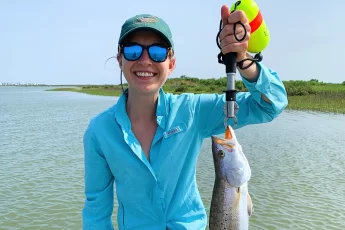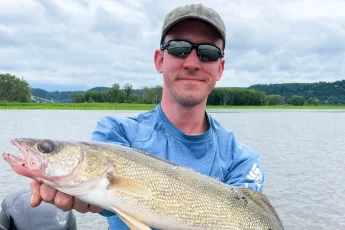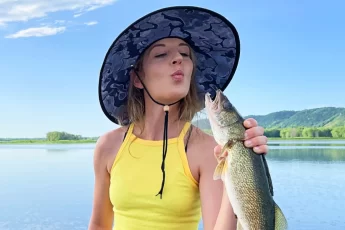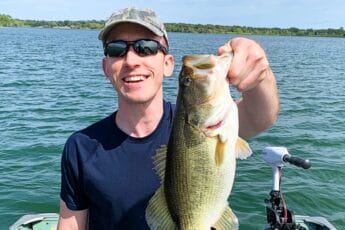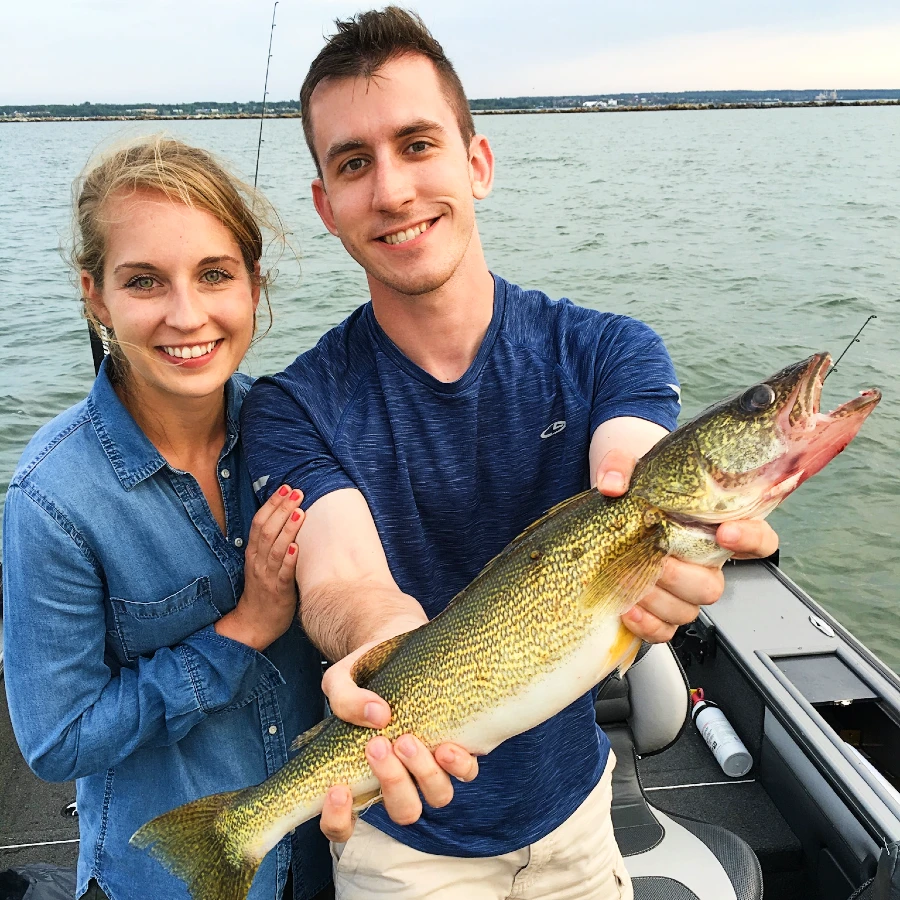
Published 10/17/2023
Like many anglers, I’ve often wondered about the best walleye fishing spots in Wisconsin. While anecdotes like “back in my day I caught a trophy walleye on this lake” are helpful, I wanted to take it a step further and review the plethora of survey data and statistics that the hardworking folks at the Wisconsin DNR have provided over the years from net surveys, electrofishing surveys, and trawling studies.
What I’ve compiled is a data-based approach to determine the best walleye fishing spots in Wisconsin based on actual population data on walleye numbers, size, and health. Note that the Wisconsin DNR has limited resources and doesn’t do a full survey on every body of water every year. What I’ve pulled together is, in my opinion, the most relevant walleye studies to help guide you to pick a great walleye fishing destination!
*Disclosure: I only recommend products I would use myself and all opinions expressed here are my own. This post may contain affiliate links that at no additional cost to you, I may earn a small commission.
Why Wisconsin for Walleye?
Wisconsin is a premier destination for walleye fishing. The state has an array of lakes, rivers, and reservoirs teeming with healthy populations of walleye, offering both abundant catches and trophy-sized fish. The diverse water bodies, from the vast Lake Winnebago system to the picturesque Wisconsin River, provide varied habitats and challenges for both novices and experienced fishermen.
Seasonal fishing events, like the spring and fall runs, offer unique opportunities to catch walleye as they move in large numbers. Furthermore, the Wisconsin Department of Natural Resources does a great job promoting sustainable fishing practices to ensure that walleye populations remain robust.
The Best Walleye Fishing Spots
In this article, we check out some of the reports in the Wisconsin DNR’s vast library of studies and surveys to determine the best walleye fishing lakes and rivers based on walleye population statistics and data.
1. Green Bay
Green Bay is a renowned walleye fishery. The bay is fed by several tributaries which support large annual spring spawning migrations of Walleye. These rivers, combined with multiple spawning locations scattered around Green Bay, provide the ideal breeding grounds to ensure a healthy and sustainable Walleye population. Furthermore, consistent studies and management practices by institutions like the Wisconsin DNR ensure the fishery’s health and abundance.
What does the data say?
Data Source: Wisconsin DNR Green Bay Walleye Tagging Survey 2018
The Wisconsin Department of Natural Resources conducted annual electroshocking surveys from 2012 to 2018 to study Walleye spawning habits in the major Green Bay tributaries. In these surveys, Walleye were captured during their spring spawning runs, primarily below dams in several rivers, including the Menominee, Peshtigo, and Fox Rivers. The aim each spring was to capture a vast number of Walleye and tag 500 of them, evenly split between males and females. This tagging helped track Walleye movement, with anglers later reporting the locations where they caught tagged fish.
Based on the 2018 survey data, I put together the below graph of the Fox River tributary walleye spring electroshocking results.
Key Survey Takeaways:
- Trophy Walleye Opportunities: The Fox River results had a whopping 18 walleye caught that were 28 inches or above. This data unequivocally shows there are massive, trophy walleye swimming in Green Bay waters.
- Healthy Age Distribution: The presence of Walleye from various year classes, including a notable number from the large 2013 year class, indicates a sustainable population with good survival rates.
- Walleye Movement Patterns: Angler tag returns and DNR surveys indicate that while many Walleye exhibit high site fidelity, returning to their original spawning rivers, others move throughout lower Green Bay. This movement pattern gives anglers a diverse fishing experience in different parts of the bay.
If anyone knows how to consistently find and catch those 28 inch walleye, let me know!
2. Lake Winnebago
Lake Winnebago is one of the best known lakes for walleye enthusiasts. But what makes it so special? Let’s check out the data.
What does the data say?
Data Source: Wisconsin DNR 2022 Lake Winnebago Bottom Trawling Assessment Report
Unfortunately I could not find an electroshocking survey for Lake Winnebago, but I was able to find the DNR’s trawling assessment that they’ve been performing for the past 36 years! We can definitely use this data for some intelligent insights on the health of the Lake Winnebago walleye fishery.
The survey involves a series of 138 net pulls conducted over three sampling events throughout the year. Each day, the 27-foot-wide trawl net is dragged across the lake bottom, capturing a snapshot of the aquatic life below. The fish are then counted and measured before being released back into their natural habitat. This meticulous research provides an invaluable long-term dataset. By analyzing and comparing this data, fisheries managers and anglers gain profound insights into the health and abundance of fish in the lake.
Check out the 2022 Lake Winnebago Bottom Trawling Assessment Report results for adult walleye catch rates.
Key Assessment Takeaways:
- Promising Future: The Walleye year classes of 2021 and 2022 are expected to offer good angling opportunities in the coming years.
- Record Year in 2022: Winnebago System Walleye experienced a near-record year class in 2022 with a catch rate of 17.4 YOY/trawl. This rate is over three times the long-term average of 5.0 YOY/trawl and is the highest since 2008.
- 2022’s Favorable Conditions: In 2022, the Wolf River had above-average water levels that remained consistent, benefiting the Walleye spawn.
The consistent and comprehensive research approach underscores the lake’s rich walleye population. The data, spanning over three decades, reaffirms Lake Winnebago’s reputation as a prime location for walleye fishing. The insights gained from the research not only inform fisheries management but also guide anglers on when and where to cast their lines for the best chances for a bountiful catch.
3. Lake Geneva
Lake Geneva, nestled in southeastern Wisconsin, stands as a premier destination for Walleye anglers. Its clear, deep waters create an ideal habitat for Walleye, offering both shallow and deep fishing opportunities. Over the years, the lake’s Walleye population has benefited from both natural reproduction and regular stocking programs, ensuring a sustainable fishery. Anglers visiting Lake Geneva can expect not only a chance to catch good quantities of walleye, but also to experience the thrill of battling larger, mature Walleyes.
What does the data say?
Data Source: Comprehensive Fisheries Survey Report of Geneva Lake – Walworth County 2015
In 2015, the DNR performed an assortment of surveys on Geneva Lake. During the early spring fyke netting survey from April 6th to 20th, 934 walleyes were captured.. Genetic analysis on samples was done at UW-Stevens Point to determine their origin. An early spring electrofishing survey from April 21st to 23rd captured 157 walleyes and estimated a walleye population of 3,102 or 0.59 per lake acre. Fall surveys in November and December primarily targeted young-of-year walleyes and large fingerling stocking locations, capturing a total of 91 walleyes.
| Number Captured | Number Measured | Mean Length (Inches) | Max Length (Inches) | Mean Weight (Pounds) | |
|---|---|---|---|---|---|
| Female | 649 | 280 | 24.3 | 30.5 | 6.9 |
| Male | 252 | 95 | 15.2 | 21.6 | 1.4 |
| Unknown | 33 | 23 | 11.4 | 15.9 | 0.79 |
Key Survey Takeaways:
- Average Walleye Size: Average female walleye size of 24.3 inches is incredible! Any walleye angler would be ecstatic with an average fish size that high.
- Trophy Walleye Opportunities: The largest captured walleye were 30.0″ and 30.5″ females weighing 14.2 pounds and 13.5 pounds respectively. Holy cow those are trophy fish!
- Male vs Female: Females significantly outnumbered males at a ratio of 2.6:1 and were on average nine inches longer.
4. Lake Mendota
Located right next to the Madison, Lake Mendota is a popular fishing lake that spans 9,781 acres with a maximum depth of 83 feet. DNR stated management goals include maintaining an adult walleye population of 2 per acre and a lower density trophy fishery for northern pike.
What does the data say?
In 2019, the Wisconsin Department of Natural Resources (WDNR) conducted an extensive fishery assessment, targeting multiple fish species during different seasons. The walleye population was estimated at 21,302, translating to 2.2 fish per acre.
Management objectives aim to maintain or improve the fishery, with a specific focus on maintaining the adult walleye population and offering a trophy northern pike fishery.
Key Survey Takeaways:
- Length Data: Walleye sampled in Lake Mendota during spring ranged from 6” to 29.5” with an average length of 14.5”.
- Age Data: The oldest walleye was a 27” female, aged 11 years, with most fish aged between three and six years.
- Keeper-sized Fish: Legal sized fish (≥18”) had a population estimate of 2,613, ranging from 2,017 to 3,448.
- Physical Health: Walleyes had good to excellent body conditions, with only 6.0% in poor condition and an overall mean relative weight of 94.0.
Data Source: Comprehensive Fishery Survey of Lake Mendota Dane County, Wisconsin 2019
5. Lake Wisconsin
Situated in south-central Wisconsin, Lake Wisconsin is an expansive body of water offering a diverse habitat that supports healthy walleye populations. Over the years, both natural reproduction and stocking initiatives have contributed to the lake’s reputation as a prime destination for walleye fishing. The lake spans towns in Sauk and Columbia County, has a depth of 24 feet, and covers 9,000 acres.
What does the data say?
In 2017, a thorough fisheries survey was conducted on Lake Wisconsin during spring and fall. The methods included early spring electrofishing for Walleyes and Saugers on the Wisconsin River below the Kilbourn Dam, fyke netting for Northern Pike, Walleye, and Muskellunge in the lake, late spring electrofishing for bass and panfish, and a fall electrofishing survey for Walleye and Sauger recruitment. The survey found Walleyes reaching over 15 inches by age 3 and exceeding 20 inches by age 6.
Key Survey Takeaways:
- Population Size & Growth: In the survey, 2,117 Walleyes were collected. The population of Walleyes measuring at least 12 inches in a specific river segment during spawning was estimated at 11,928. Adult Walleyes, measuring at least 15 inches, were estimated at 7,261.
- Size & Age Distribution: Walleyes collected ranged from 6.0 to 30.1 inches in length, with an average of 16 inches. The most common ages were 1, 3, and 8 years. The growth rate of Walleyes in Lake Wisconsin is faster than regional and state averages, reaching the minimum harvest size of 15 inches as early as age 3.
- Sex-based Differences: Male Walleyes ranged between 2 to 12 years, with 91% being age 4 or younger. Female Walleyes ranged from 3 to 15 years, with a peak in the distribution at age 8. Females generally exceeded the minimum length limit, averaging 17.6 inches by age 3.
- Body Condition: Overall, the body condition of Walleyes was good. The body condition was positively correlated with the size of the fish.
All this points towards Lake Wisconsin being an excellent destination for both quantity and size of walleye!
Data Source: Comprehensive Fisheries Survey of Lake Wisconsin, Columbia County and Sauk County, Wisconsin 2017
Conclusion
In conclusion, Wisconsin is a gold mine for walleye enthusiasts and boasts a myriad of incredible fishing locations. Through a meticulous examination of data and surveys from the Wisconsin Department of Natural Resources, we’ve highlighted some of the best walleye fisheries in the state. From the trophy walleyes in Green Bay to the robust populations in Lake Wisconsin, each spot offers a unique fishing experience backed by concrete numbers. Whether you’re an angler seeking your next big catch or simply looking to enjoy a beautiful fishing day, Wisconsin’s top walleye destinations promise unforgettable experiences. So gear up, and here’s hoping your next fishing trip is as rewarding as the data suggests!
Check out our related walleye content so you have the gear and techniques to catch more walleye!
- Walleye Fishing Equipment
- Beginner Guide on How to Catch Walleye
- Best Walleye Fishing Techniques
- Walleye Fishing Techniques
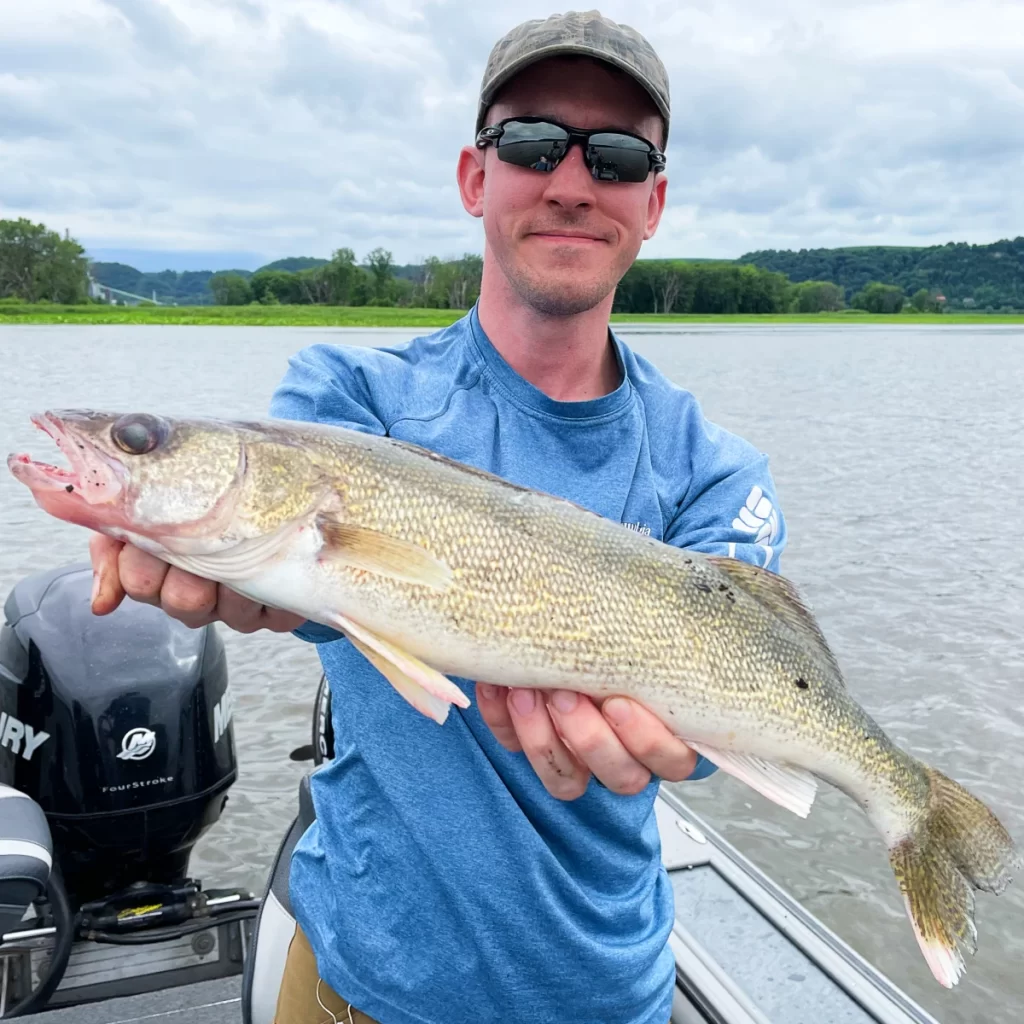
Written By: Andrew Juran
Andrew is a seasoned angler with over 25 years of experience specializing in walleye fishing on the Mississippi river and assorted lakes in Wisconsin. He has caught hundreds of walleye using various techniques and mentored many in the art of walleye fishing. An advocate for sustainable fishing, Andrew is an active member of the Coastal Conservation Association, an organization committed to marine conservation.
For frequent fishing tips, behind-the-scenes looks, and real-time catches, connect with Andrew on Instagram

